Frame: This smooth gold leaf frame is typical of many DGR pictures from
about 1868 forward. It has “simple, rather severe
mouldings on either side of very broad, shallow bevelled boards.
Large roundels are set into the boards . . . usually placed singly
at the mid-point of each side of the painting.”
In this particular case the roundels and frame inscriptions are closely
integrated to the painting. The roundels “were
possibly inspired by the margin decorations in Plate 14 of Blake's
Job—
The Days of Creation. The texts
had been used before by Rossetti as early as 1856 on the original
frame of the water-color
Dante's Dream
. At the bottom is inscribed the line from
Jeremiah, Lamentations I, i, quoted by Dante in the
Vita Nuova on the death of Beatrice
Quomodo sedet sola Civitas!; at the top is the date of Beatrice's death, now partly
erased,
Jun: Die 9: Anno 1290”
(Grieve
23). The roundels placed midway on each side of the frame are contain
relief representations of (at the top) the rising sun, (on the right)
the stars, (on the left) a crescent moon embracing a single star, and
(at the bottom) a land and seascape with the inscription “9
Giugno 1290.” “They symbolize, in a much
more naturalistic way, the same forces that were symbolized by the
schematic roundels on the frame of the 1854
Salutation of Beatrice
and again probably relate to the closing lines of the
Commedia (
Paradiso XXXIII. 143-145)” (Grieve23).
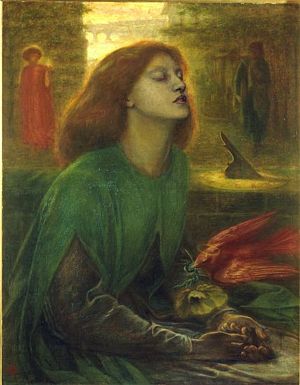
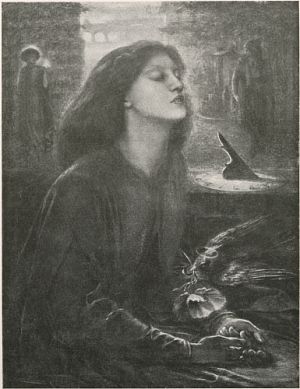
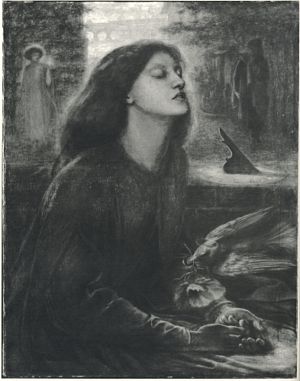
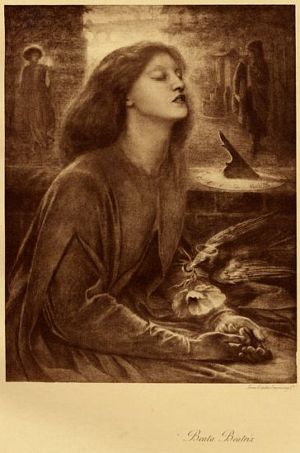
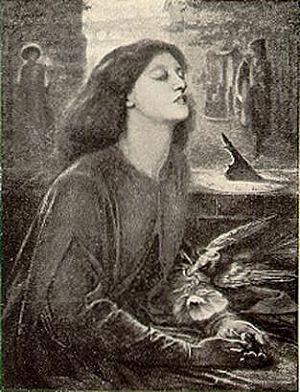
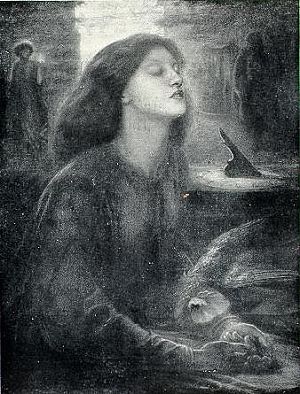
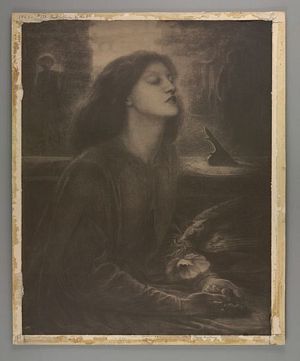
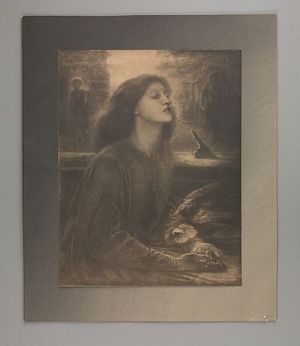
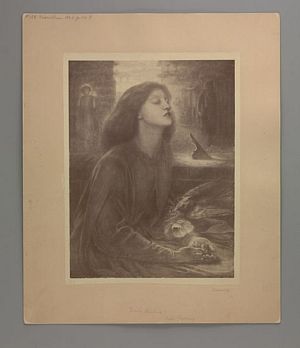
Scholarly Commentary
Introduction
This is the original painting, now in the Tate Gallery—an outstanding example of DGR's symbolist work. The picture is executed like DGR's watercolors of the 1850s rather than the oils of the 1860s, as one sees in the chalky painting surface, the undefined contours, and what Gabriele Reithmiller calls “the subdued luminosity of the colors separated from each other in compact compartments . . . to emphasize contrasting color fields” rather than to support a realistic representation.
In terms of composition the picture illustrates a typical planarity of approach. Foreground and background are organized not by perspective but by emblematic relations. Indeed, DGR deliberately sought for an organization after the manner of what he called “the old Italian painters” (in his letter to Ellen Heaton of 19 May 1863, when he took up his work on the picture after he had set it aside). DGR's symbolist technique, so unlike the“old Italian painters,” should not obscure his compositional models in primitive art.
A non-realist approach governs the deployment of light in the picture. The placement of Beatrice's head turns what is formally a realistic moment (sunlight from the distant city) into something far more emblematic. Beatrice's head is virtually in an aureole, as is the figure of Love at the left (and as Dante's, at the right, is not). The influence of stained glass lighting is very clear in a painting like this, although Ruskin judged it to be characteristic of all his work up to the mid-60s: “Its light is not the light of sunshine itself, but of sunshine diffused through coloured glass” ( The Art of England in Works of John Ruskin, vol. 33, 271). Most important, the painting's inner golds connect to the outer, highly symbolic and decorative frame. The result is that the painting seems illuminated out of its own materials, and not from some imagined realistic source of light. This integration of the painting and the frame via color and symbolic paraphernalia dramatizes the simplicity of the symbolical character of the color organization of the work—a “sombre harmony of gold and green and purple,” as Waugh noted (Waugh 122). The white underpainting, notable at the lower right and in Beatrice's sleeves, lends a strange luminosity to the largely darkened space dominated by the figure of Beatrice, and is an important element contributing to the work's power of spiritual suggestion.
There are many replicas of various kinds, each representing a very different approach to the subject. A comparative study of the different versions of this work reveals a great deal about DGR's way of proceeding with replicas. The common view is that because he wanted the money he could get for these projects, and because he often complained about the work, that therefore the replicas are relatively unimportant. But the series of Beata Beatrix pictures clearly show his interest in using such work to re-examine and re-interpret his subject.
Production History
Various letters from DGR show that he had begun studies and even a painting of his wife Elizabeth as Dante's Beatrice sometime before her suicide-death in early 1862 (see SurteesI. 93-94). DGR told Ellen Heaton in 1863 that he had “lately found” the unfinished painting and that he now wanted to finish it. At that point DGR imagined that “The background of the picture should be a landscape one, introducing after the manner of the old Italian painters, scenes from Dante, bearing on its main subject” (quoted in SurteesI. 94). WMR dates the recommencement in 1864, and in 1870 the picture was completed for the Honble. William Cowper-Temple (later Lord Mount Temple).
The picture was a celebrated work from the beginning, and DGR did a number of replicas and drawings, the most important being the oil replica he did for William Graham in 1872, to which he added a predella.
Reception
The picture was recognized as a masterpiece from the beginning, as all the early notices show. The numerous replicas and related drawings testify to its fame as well.
Iconograpic
The iconography is centrally Rossettian. The subject, imagined out of Dante, represents Beatrice in a tranced state, caught in a kind of fore-dream of her heavenly translation.
Various commentators point out that the poppy borne by the mystical bird (an Annunciation figure as well as a sign of the Holy Spirit) emblemizes death, and perhaps chastity and peace as well. The red coloring of the dove is dramatically nonnaturalistic; iconographically it signifies love and passion. Stephens, presumably with the concurrence of the artist, says that Beatrice is sitting “in a balcony of her father's palace in Florence. The picture places us in the chamber from which the balcony opens, and the damsel's form is half lost against the outer light, half merged with the inner shadows of the place. She is herself a vision while . . . the heavenly visions of the New Life are revealed to the eyes of her spirit. The open window gives a view of the Arno, its bridge, and the towers and palaces of that city in which Dante and Beatrix spent their lives till the fatal month of June 1290, when she died, and, as the poet tells us, ‘the whole city came to be, as it were, widowed and despoiled of all dignity . . .’ In the background the poet Dante attentively regards the figure of Love, the ideal Eros of his vision, who, holding a flaming heart, passes on the other side of the picture heavenwards, and seems to sign to him that he should follow in that path” ( Stephens64). Dante carries a book, presumably the Vita Nuova and stands near a well, symbolizing rebirth and the New Life that Beatrice is dreaming toward. An Arbor Vitae is faintly visible behind the figure of Love at the left background.
It is worth noting that all the background details of this picture, including the cityscape, are much more schematically presented than they are in other, later versions of the subject, particularly the Graham version. The point is particularly relevant when one considers the autobiographical dimensions of the work. The river, bride, and city may be literally (or literarily) the Arno, Ponte Vecchio, and Florence, but they can and should equally be seen as the Thames and south London, with the many arches of the old Battersea Bridge spanning the river.
Pictorial
The painting's traditional association with The House of Life sonnet “ The Portrait” necessarily draws it into a relation with another work, The Portrait , which DGR executed in 1869 with Jane Morris as the model. It also resembles the magnificent St. Cecilia drawing he did for the Moxon Tennyson volume.
The tranced pose of Beatrice distinctly recalls the pose DGR had Elizabeth Siddal take when she sat for his early picture The Return of Tibullus to Delia ( SurteesI. 94).
The picture should also be connected with DGR's drawing and watercolor of The First Anniversary of the Death of Beatrice , which pictures the incident of Dante drawing an angel, recorded in the Vita Nuova XXXIV. DGR of course associated himself and his work with Dante in the closest way, so that in the case of the Beata Beatrix project his own painting would stand as the equivalent of Dante's angel-drawing.
Literary
The picture has often been linked to The House of Life sonnet “ The Portrait,” but there is no explicit indication that DGR saw sonnet and picture comprising a “double work.”
The Dantescan connection, to the Vita Nuova, is one that DGR imagined for the picture from its earliest states, as we see from his various letters about to the work—e.g., to The Hon. Mrs. Cowper-Temple (26 March 1871) and to Ellen Heaton (19 May and 22 December 1863). Compare in particular Dante's canzone in the Vita Nuova section XXXI (“Li occhi dolenti per pieta del core,” lines 24-28), which is translated by DGR as “The eyes that weep for pity of the heart” (see DGR's translation lines 23-28).
Autobiographical
DGR always regarded Beata Beatrix as a kind of memorial to his dead wife (she was the model for the painting). Although earlier scholars were unaware of the fact, DGR had done considerable work on the painting before his wife's suicide in 1862. The painting was therefore invested with deep personal, and more particularly Dantescan, qualities for DGR. That is to say, DGR would have been able to see the painting as a kind of prophetic construction of Elizabeth as Beatrice, whose death assumed mythic significance for Dante. Moreover, in this version of the painting the cityscape background could as well suggest the Thames, the old Battersea Bridge, and south London viewed from Cheyne Walk as it could the Arno, the Ponte Vecchio, and the skyline of Florence viewed from Beatrice's father's house.
As so often with DGR's mythic imaginations, however, he also saw his other great love, Jane Morris, in the figure of Beatrice, as we know most directly from the exquisite watercolor he did of her in 1872, Jane Morris as Beatrice (Lady in a Blue Dress) .
Bibliography